Review of Municipal Organic Waste Management in Uttar Pradesh State, India
Abstract
:1. Introduction
2. Overview of the Study Area and Existing Waste Management Situation
3. Legal, Institutional, and Financial Frameworks
4. Waste Generation and Composition
5. Waste Collection and Transportation
6. Treatment and Final Disposal of Municipal Organic Waste
7. Bridging the Gaps in Existing Organic Waste Management
7.1. Administrative Aspects
7.2. Regulation Aspects
7.3. Institutional Aspects
7.4. Financial Aspects
7.5. Technical Aspects
7.5.1. Utilizing Organic Waste to Feed Animals
7.5.2. Management at the Source and Decentralized Composting Plants
7.5.3. Improving Processing and Treatment of Residual Municipal Organic Waste
8. Conclusions
Author Contributions
Funding
Institutional Review Board Statement
Data Availability Statement
Conflicts of Interest
References
- Central Pollution Control Bord. Implementation of Solid Waste Management Rules: (As per Provision 24(4) of SWM Rules, 16); Central Pollution Control Bord: Delhi, India, 2019. [Google Scholar]
- Urban Development Department Government of Uttar Pradesh. Uttar Pradesh State Solid Waste Management Policy; Urban Development Department Government of Uttar Pradesh: Lucknow, India, 2021.
- Government of India. Population Projection for India and States 2011–2036. Report of the Technical Group on Population Projections; National Commission on Population: New Delhi, India, 2020.
- Planning Commission, Government of India. Report of the Task Force on Waste to Energy (Volume I) in the Context of Integrated Municipal Solid Waste Management; Planning Commission, Government of India: New Delhi, India, 2014.
- Sharholy, M.; Ahmad, K.; Mahmood, G.; Trivedi, R.C. Municipal solid waste management in Indian cities—A review. Waste Manag. 2008, 28, 459–467. [Google Scholar] [CrossRef] [PubMed]
- Zabaleta, I.; Mertenat, A.; Scholten, L.; Zurbrügg, C. (Eds.) Selecting Organic Waste Treatment Technologies. SOWATT; Eawag: Dübendorf, Switzerland, 2020. [Google Scholar]
- Alam, P.; Sharholy, M.; Ahmad, K. A Study on the Landfill Leachate and Its Impact on Groundwater Quality of Ghazipur Area, New Delhi, India. In Recent Developments in Waste Management; Kalamdhad, A.S., Ed.; Springer: Singapore, 2020; pp. 345–358. [Google Scholar]
- Choudhary, A. Swachh Bharat Mission- Need, Objective and Impact. Int. J. Res. Manag. Pharm. 2017, 6, 5–9. [Google Scholar]
- Mohan, G.; Sinha, U.K.; Lal, M. Managing of Solid Waste through Public Private Partnership Model. Procedia Environ. Sci. 2016, 35, 158–168. [Google Scholar] [CrossRef]
- Central Public Health and Environmental Engineering Organisation. Municipal Solid Waste Management Manual; Ministry of Urban Development, Government of India: New Delhi, India, 2016.
- Baskar, C.; Ramakrishna, S.; Baskar, S.; Sharma, R.; Chinnappan, A.; Sehrawat, R. (Eds.) Handbook of Solid Waste Management: Sustainability through Circular Economy; Springer: Singapore, 2020. [Google Scholar]
- Gupta, N.; Yadav, K.K.; Kumar, V. A review on current status of municipal solid waste management in India. J. Environ. Sci. 2015, 37, 206–217. [Google Scholar] [CrossRef] [PubMed]
- Yadav, S.; Negi, M.S. The Impacts on Environment and Health of Residents: A Case Study of Ghazipur Dumpsite (Landfill), East Delhi. In Population, Sanitation and Health; Alam, A., Rukhsana, Islam, N., Sarkar, B., Roy, R., Eds.; Springer: Cham, Switzerland, 2023; pp. 125–135. [Google Scholar]
- Agarwal, D.; Gupta, A.K.; Agarwal, M.K. Analysis of Solid Waste Management Strategies in Major Cities of Uttar Pradesh in India. J. Pure Appl. Sci. Technol. 2012, 2, 66–74. [Google Scholar]
- Rana, R.; Ganguly, R.; Gupta, A.K. Life-cycle assessment of municipal solid-waste management strategies in Tricity region of India. J. Mater. Cycles Waste Manag. 2019, 21, 606–623. [Google Scholar] [CrossRef]
- Srivastava, V.; Vaish, B.; Singh, R.P.; Singh, P. An insight to municipal solid waste management of Varanasi city, India, and appraisal of vermicomposting as its efficient management approach. Environ. Monit. Assess. 2020, 192, 191. [Google Scholar] [CrossRef] [PubMed]
- Rothenberger, S.; Zurbrügg, C. Decentralised Composting for Cities of Low- and Middle-Income Countries: A Users’ Manual; Waste Concern: Duebendorf, Switzerland, 2006. [Google Scholar]
- Atin, B.; Shailshree, T.; Subhasish, P. (Eds.) Decentralized-Management-of-Segregated-Organic-Waste; Centre for Science and Environment: New Delhi, India, 2021. [Google Scholar]
- Friege, H. Separate Collection of Waste Fractions: Economic Opportunities and Problems. Source Sep. Recycl. 2017, 63, 11–29. [Google Scholar] [CrossRef]
- Gupta, K.K.; Aneja, K.R.; Rana, D. Current status of cow dung as a bioresource for sustainable development. Bioresour. Bioprocess. 2016, 3, 28. [Google Scholar] [CrossRef]
- Eggemann, L.; Rau, F.; Stolten, D. The ecological potential of manure utilisation in small-scale biogas plants. Appl. Energy 2023, 331, 120445. [Google Scholar] [CrossRef]
- Friege, H.; Eger, Y. Best practice for bio-waste collection as a prerequisite for high-quality compost. Waste Manag. Res. J. Int. Solid Wastes Public Clean. Assoc. ISWA 2022, 40, 104–110. [Google Scholar] [CrossRef] [PubMed]
- Reichel, E. Bio-Waste in Europe. Turning Challenges into Opportunities; Publications Office of the European Union: Luxembourg, 2020; Volume 4. [Google Scholar]
- Mohan, S.; Joseph, C.P. Potential Hazards due to Municipal Solid Waste Open Dumping in India. J. Indian Inst. Sci. 2021, 101, 523–536. [Google Scholar] [CrossRef]
- Somani, M.; Srivastava, R.K. Regionalization of Solid Waste Management: A Proposal for Divisional Landfill in the State of Uttar Pradesh, India. J. Hazard. Toxic Radioact. Waste 2021, 25, 05020006. [Google Scholar] [CrossRef]
- Azevedo, B.D.; Scavarda, L.F.; Caiado, R.G.G.; Fuss, M. Improving urban household solid waste management in developing countries based on the German experience. Waste Manag. 2021, 120, 772–783. [Google Scholar] [CrossRef] [PubMed]
- Sharma, B.K.; Chandel, M.K. Life cycle assessment of potential municipal solid waste management strategies for Mumbai, India. Waste Manag. Res. J. Int. Solid Wastes Public Clean. Assoc. ISWA 2017, 35, 79–91. [Google Scholar] [CrossRef] [PubMed]
- Cheela, V.; John, M.; Biswas, W.; Dubey, B. Environmental Impact Evaluation of Current Municipal Solid Waste Treatments in India Using Life Cycle Assessment. Energies 2021, 14, 3133. [Google Scholar] [CrossRef]
- Ekanthalu, V.S.; Hemidat, S.; Hartard, S.; Morscheck, G.; Narra, M.-M.; Narra, S.; Sprafke, J.A.; Nelles, M. Waste Value Potential Analysis of Municipal Solid Waste Produced in the Peri-Urban Area of Zhaoquanying, China. WIT Trans. Ecol. Environ. 2020, 247, 25–34. [Google Scholar] [CrossRef]
- Ghosh, S.K. (Ed.) Waste Management and Resource Efficiency: Proceedings of 6th IconSWM 2016, 1st ed.; Springer: Singapore, 2019. [Google Scholar]
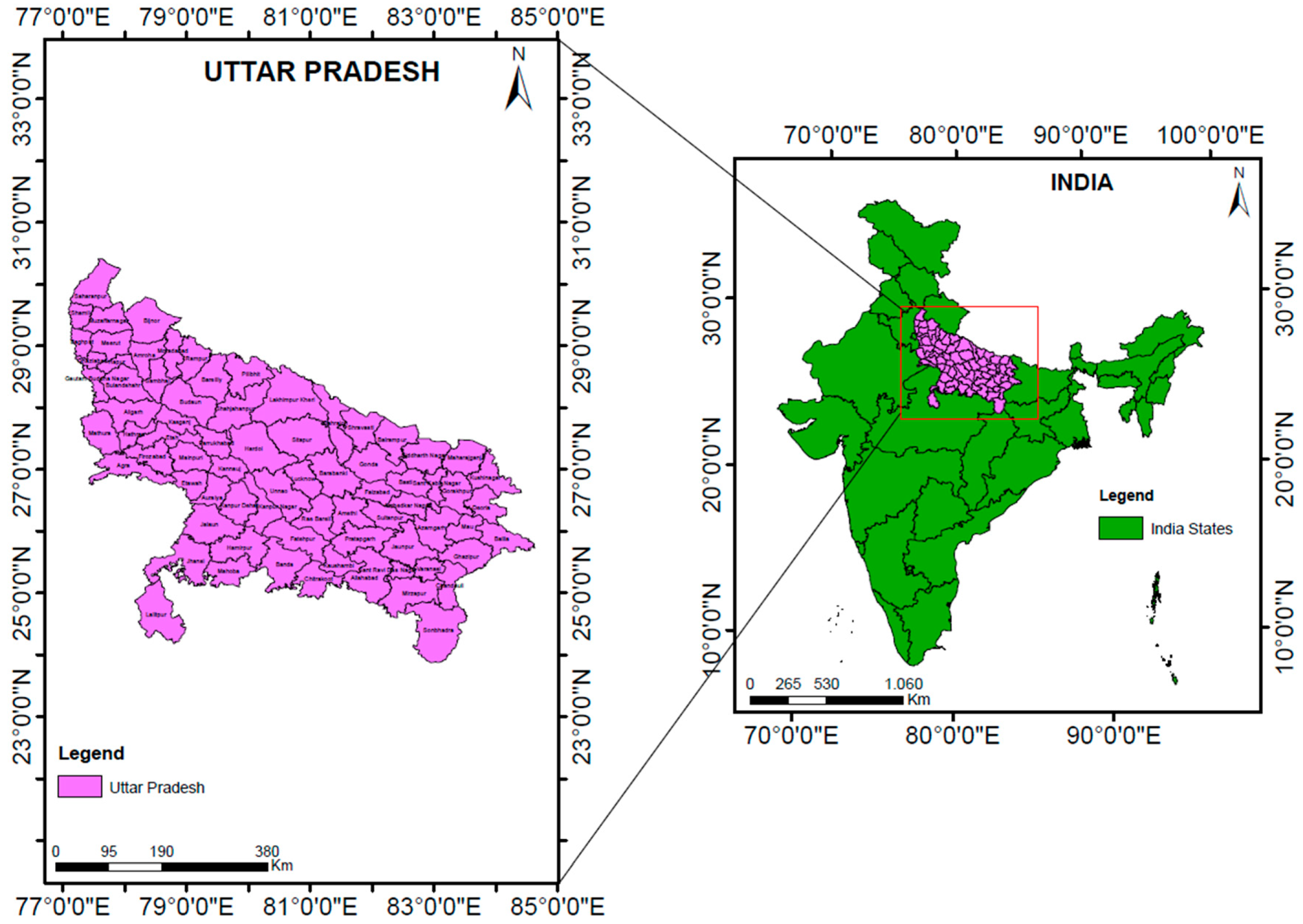
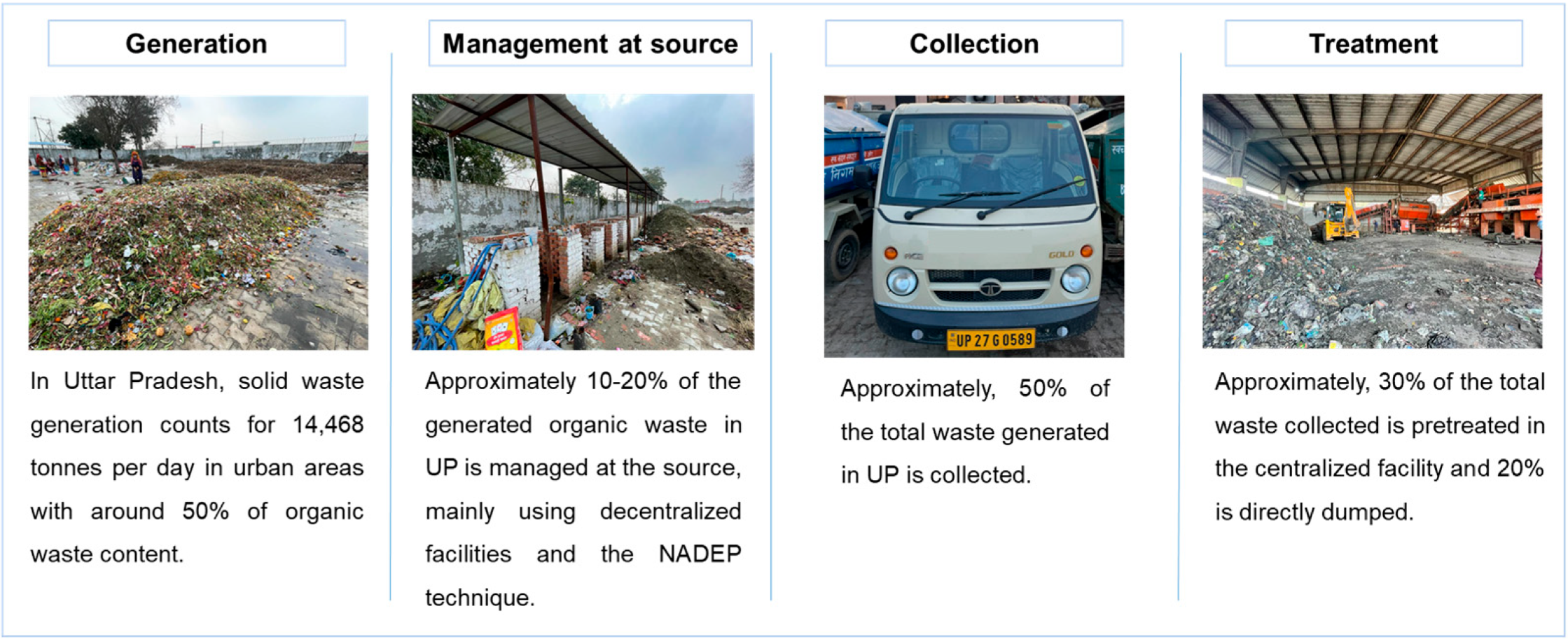
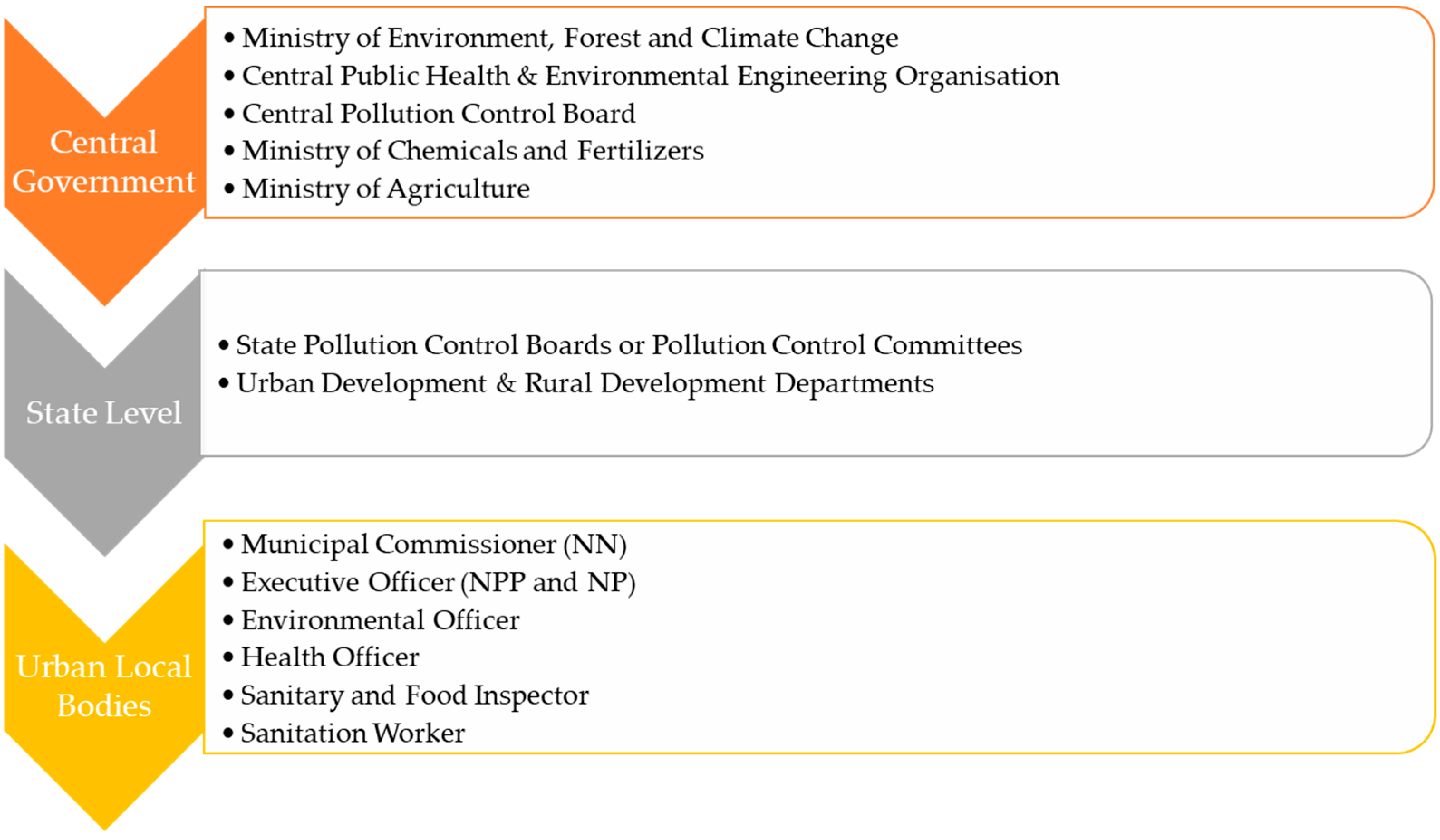
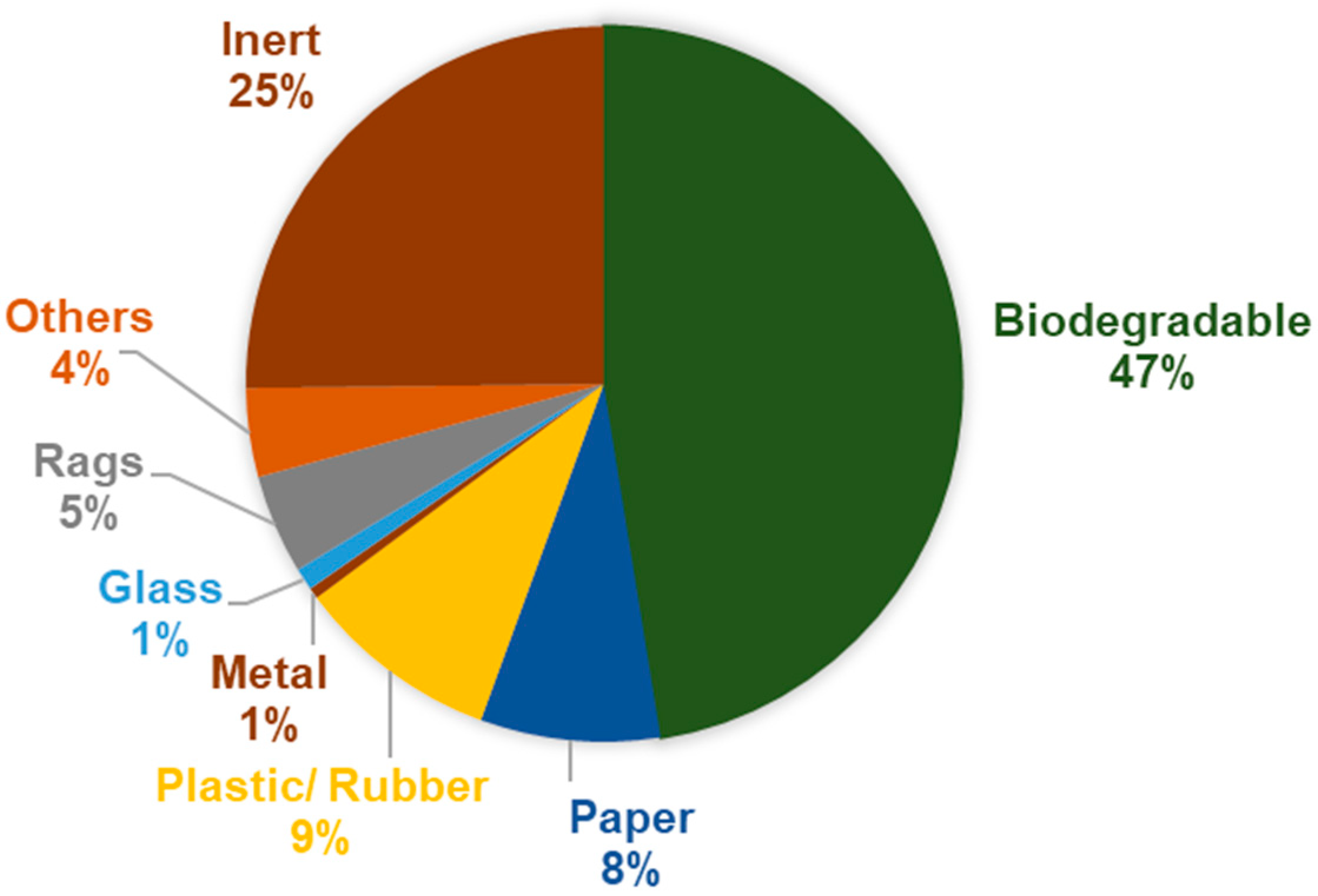
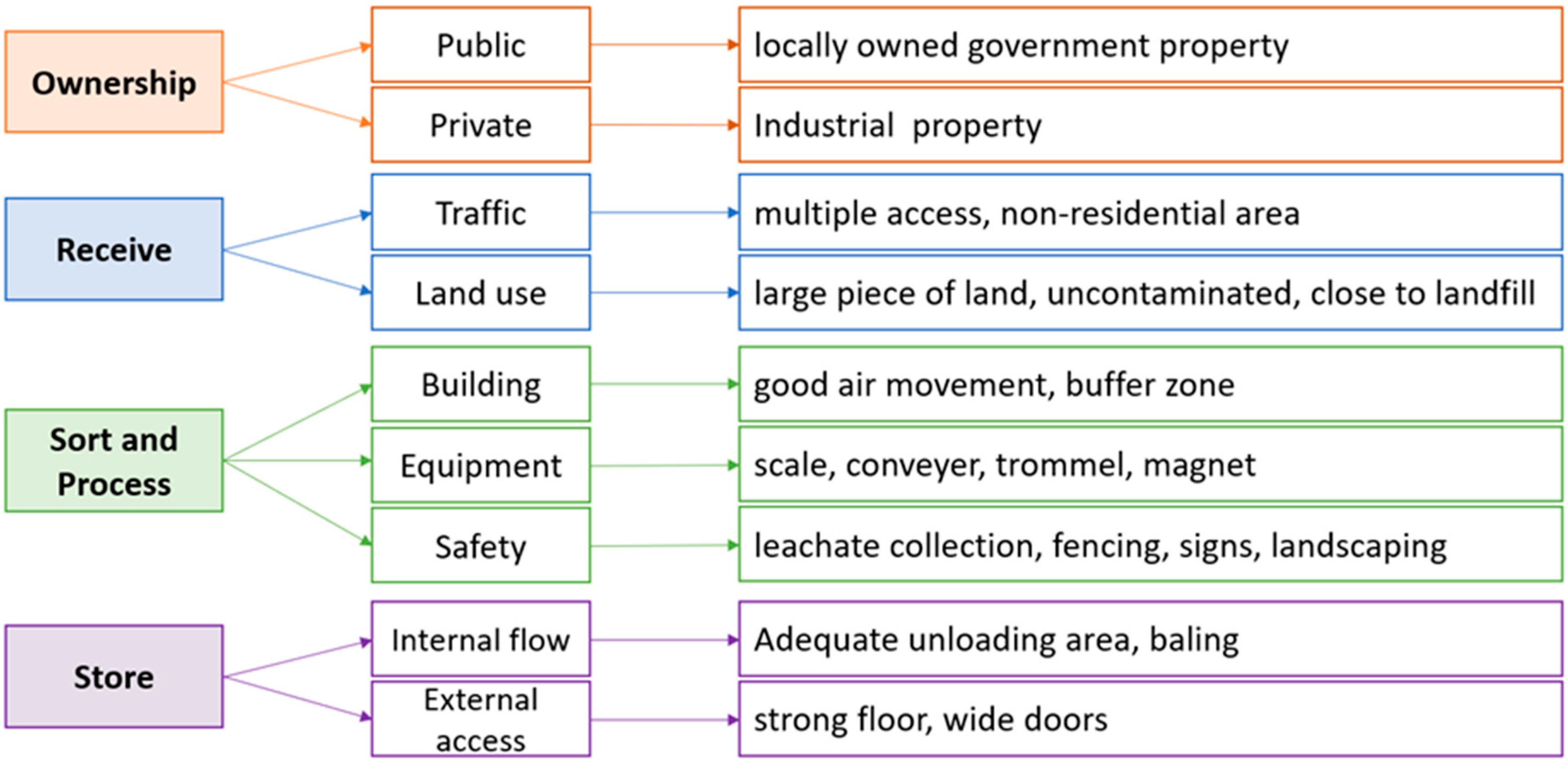
| Processing Facility | Capacity (Tonnes per Day) |
|---|---|
| Prayagraj | 600 |
| Barabanki | 30 |
| Etawah | 75 |
| Kannauj | 25 |
| Mainpuri | 30 |
| Pilkhua | 45 |
| Muzaffar Nagar | 120 |
| Raebareli | 70 |
| Aligarh | 220 |
| Lucknow | 1300 |
| Varanasi | 600 |
| Kanpur | 1500 |
| Agra | 300 |
| Moradabad | 300 |
| Mathura | 180 |
| Method | Feedstock | Capacity | Area | Time | Investment | |
|---|---|---|---|---|---|---|
| Household | Bucket | Kitchen waste | 1 kg | 1 m2 | 45 days | Low |
| Basket | ||||||
| Tri-pot | ||||||
| Tri-bin | ||||||
| Community-based | Pit | Kitchen waste Animal manure Garden trimming | 8–10 kg | 85 m2. Tonnes per day | 45 days | Moderate |
| Ring | ||||||
| HDPE container | ||||||
| Decentralized | NADEP | Kitchen waste Market waste Animal manure Garden trimming | 100 kg 50,000 kg | 85 m2. Tonnes per day 300–580 m2. Tonnes per day | 8 weeks | Moderate to high |
| Vermicompost |
Disclaimer/Publisher’s Note: The statements, opinions and data contained in all publications are solely those of the individual author(s) and contributor(s) and not of MDPI and/or the editor(s). MDPI and/or the editor(s) disclaim responsibility for any injury to people or property resulting from any ideas, methods, instructions or products referred to in the content. |
© 2024 by the authors. Licensee MDPI, Basel, Switzerland. This article is an open access article distributed under the terms and conditions of the Creative Commons Attribution (CC BY) license (https://creativecommons.org/licenses/by/4.0/).
Share and Cite
Jalalipour, H.; Narra, S.; Ekanthalu, V.S.; Antwi, E.; Ranjan, A.; Kaur, S.; Nagar, B.B.; Markart, S.; Seneviratne, T.; Singh, V.; et al. Review of Municipal Organic Waste Management in Uttar Pradesh State, India. Sustainability 2024, 16, 4909. https://doi.org/10.3390/su16124909
Jalalipour H, Narra S, Ekanthalu VS, Antwi E, Ranjan A, Kaur S, Nagar BB, Markart S, Seneviratne T, Singh V, et al. Review of Municipal Organic Waste Management in Uttar Pradesh State, India. Sustainability. 2024; 16(12):4909. https://doi.org/10.3390/su16124909
Chicago/Turabian StyleJalalipour, Haniyeh, Satyanarayana Narra, Vicky Shettigondahalli Ekanthalu, Edward Antwi, Alok Ranjan, Supreet Kaur, Bharat Bhushan Nagar, Sebastian Markart, Thilanka Seneviratne, Vidhi Singh, and et al. 2024. "Review of Municipal Organic Waste Management in Uttar Pradesh State, India" Sustainability 16, no. 12: 4909. https://doi.org/10.3390/su16124909
APA StyleJalalipour, H., Narra, S., Ekanthalu, V. S., Antwi, E., Ranjan, A., Kaur, S., Nagar, B. B., Markart, S., Seneviratne, T., Singh, V., Narra, M. M., & Nelles, M. (2024). Review of Municipal Organic Waste Management in Uttar Pradesh State, India. Sustainability, 16(12), 4909. https://doi.org/10.3390/su16124909









